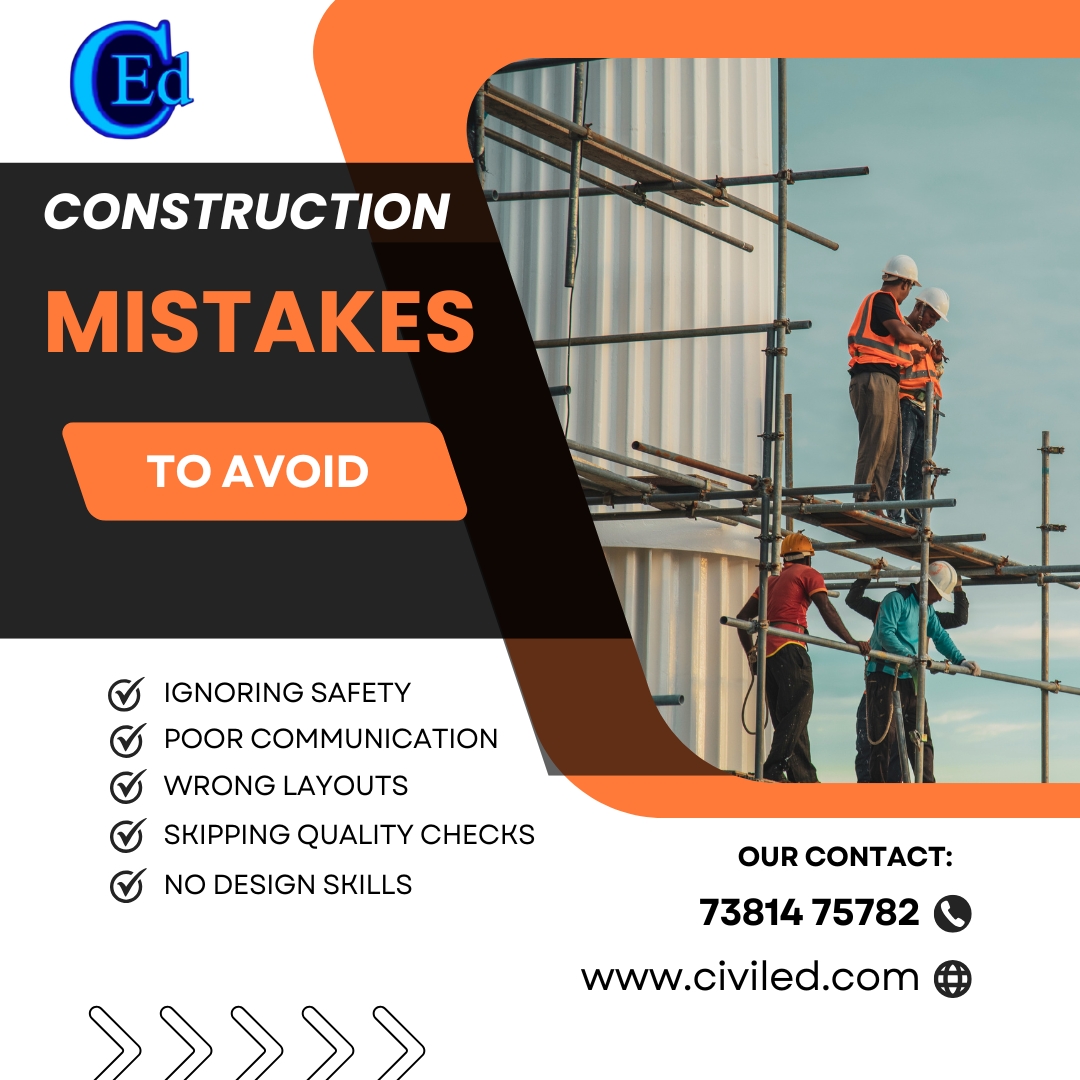Stepping onto a construction site for the first time is both exciting and intimidating. The theories you learned in classrooms finally meet the dust, sweat, and real-time problem-solving of actual project work. But as a new civil engineer, making avoidable mistakes at this stage can cost time, safety, money—and most importantly, your credibility.
Whether you’re overseeing site layouts or supervising concrete pours, knowing what not to do is as critical as knowing what to do. Based on industry experience, here are the five most common construction site mistakes that new engineers should actively avoid.
1. Ignoring Safety Protocols
One of the biggest mistakes new engineers make is underestimating the importance of on-site safety. You might be focused on meeting deadlines or making a good impression, but overlooking safety practices can lead to serious accidents.
What often goes wrong:
- Not wearing PPE (personal protective equipment) consistently.
- Failing to check if safety signs, barricades, or emergency exits are in place.
- Letting workers proceed without harnesses or helmets in risky zones.
How to avoid it:
As an engineer, you’re not just a passive observer—you set the tone. Ensure every safety rule is followed, brief teams daily, and perform random audits. Use a safety checklist for every site visit, and never hesitate to raise a concern, even if you’re new.
🛠 Pro Tip: The best engineers are those who care about people first. Safety is never “someone else’s job.”
2. Poor Communication with Site Teams
Your job doesn’t end with drawing interpretations or inspection notes. Effective communication is vital—especially between field workers, contractors, vendors, and senior engineers.
Common errors:
- Speaking too technically with laborers who might not understand engineering terms.
- Not confirming if instructions are understood or implemented correctly.
- Failing to document verbal instructions.
How to avoid it:
Build rapport with workers. Use clear, simple language and visuals when necessary. Confirm instructions by repeating key steps. Keep a written log or WhatsApp communication trail with timestamps for accountability.
🛠 Pro Tip: Engineers who communicate clearly are the ones project managers rely on the most.
3. Overlooking Site Layout Accuracy
The layout phase is the backbone of every construction project. A miscalculation at this stage—whether in marking the foundation or aligning columns—can lead to rework, wasted material, or even structural issues later.
Where it goes wrong:
- Assuming drawings are 100% error-free.
- Relying solely on senior workers to check measurements.
- Not double-checking with total station equipment or benchmarks.
How to avoid it:
Always cross-check layout dimensions with the latest drawings. Use survey instruments and take readings from fixed reference points. Keep a layout checklist and validate your work before execution begins.
🛠 Pro Tip: Want to impress your seniors? Be the one who catches a critical layout error before it becomes a structural flaw.
4. Neglecting Material and Quality Checks
New engineers often assume that materials delivered on-site are as per specification. However, poor-quality materials can affect the strength, durability, and safety of the structure.
Typical lapses include:
- Not checking cement expiry dates or storage conditions.
- Ignoring concrete mix ratios.
- Missing inspection of steel rust, bend angles, or length before use.
How to avoid it:
Maintain a checklist for material inspection and ensure every batch is verified before use. Learn how to identify quality through visual inspection and basic tests. Keep records of test results like cube strength, slump, and steel tensile tests.
🛠 Pro Tip: Good engineers don’t just manage work—they protect the quality of everything going into the structure.
5. Not Understanding Structural Design Tools
Many fresh engineers arrive on-site without practical understanding of software like STAAD Pro, ETABS, or AutoCAD. While you might not need to run full simulations on-site, having a strong grasp of design logic helps you understand why a drawing is structured a certain way.
The risk?
- You miss structural mismatches between plan and actual work.
- You can’t suggest or question field modifications.
- You become dependent on others for even basic drawing clarifications.
How to avoid it:
Before joining or while working on-site, invest in a hands-on STAAD Pro. Training program that focuses on real-time applications, structural analysis, and design logic. Civiled Design Consultancy Pvt Ltd offers exactly that—industry-aligned training for both students and working professionals, built on live projects and experienced mentorship.
🛠 Pro Tip: Engineers who understand structure don’t just follow orders—they think, question, and lead.
Conclusion
The construction industry values precision, planning, and proactive engineers. Avoiding these five mistakes not only keeps your site safe and efficient—it sets you apart as someone with leadership potential.
Whether you’re still in college or already on your first job site, taking time to learn beyond textbooks is the best investment you can make in your civil engineering journey.
Ready to Upgrade Your Skills?
At Civiled Design Consultancy Pvt Ltd, we help students and professionals like you bridge the gap between theory and practice. Our STAAD Pro. training is crafted with industry relevance, real-world examples, and project simulations that make you site-ready and confident.
📞 Contact Us Today: 73814 75782


